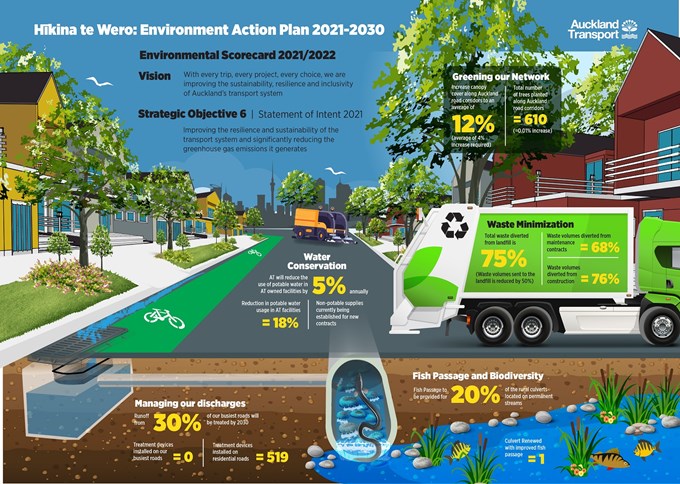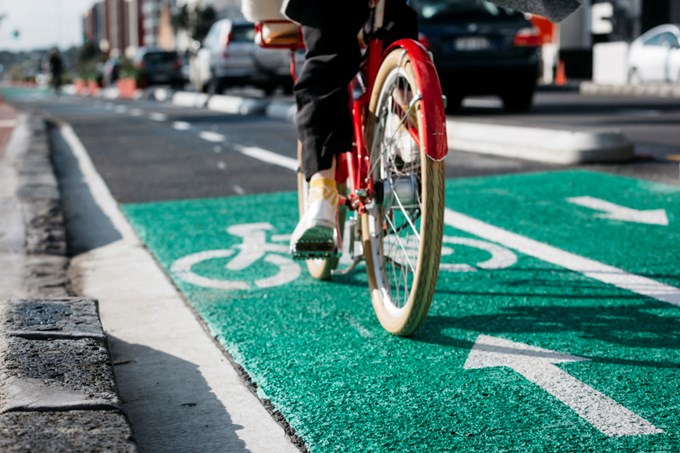The five targets and how we are tracking are set out below:
Greening our Network
What is this? Many parts of Auckland have amazing street trees. On top of looking great and providing shade, street trees provide oxygen that we need to breathe, they reduce the amount of stormwater runoff and in turn reduce flooding and clean our stormwater, and they provide a home for much of our precious wildlife. We are aiming to increase the number of street trees and planting in areas where they are lacking, a particular focus area is South Auckland. Street trees are really important for providing shade and reducing the heat for pedestrians in summer, helping our communities be resilient to climate change.
Targets: Increase tree cover along Auckland streets to an average of 12 per cent and help our streets become 10 per cent more spongy to reduce stormwater runoff and to replenish our ground water. We do this through things like planting trees, rain gardens, and green roofs.
How will we measure this: We will record and track the areas of green infrastructure and spongy surfaces on the street. In collaboration with Auckland Council, we will regularly measure the canopy cover and street trees, particularly in south Auckland.
How are we tracking? This year we planted 610 new street trees and we trialled living shelters at two of our bus stops. The living shelters included green roofs and green walls and we are monitoring these to see how the plants survive in summer before rolling these out across Auckland.
Water Conservation
What is this? This is about not wasting drinking water by using it to keep the dust down during construction. Auckland has experienced a water shortage in recent years and drinking water is precious, let’s not waste it for construction.
Targets: All AT capital/maintenance projects over $5 million will establish rainwater supplies for activities that do not need drinking-water quality water. And AT will reduce the use of drinkable water by 5 per cent annually at our bus, train, and ferry stations.
How will we measure this? The use of rainwater for construction, maintenance and operational needs will be tracked and reported by our contractors and staff. AT also tracks the use of water at our bus, train, and ferry stations.
How are we tracking? Most of our major contractors now have rainwater tanks installed at their depots for construction and maintenance work. Our stations saved 18 per cent of water in the last year, partly due to COVID-19.
Fish Passage and Biodiversity
What is this? Fish sometimes need to travel through our drainpipes to reach habitats and breeding grounds, and sometimes this access is blocked. Fish contribute to the biodiversity of New Zealand and are an important part of supporting our native bird species. A healthy and thriving ecosystem is part of creating a healthy city.
Target: Fish passage will be provided for 20 per cent of the rural drainpipes (culverts) located on streams where fish live.
How will we measure this? We will check the condition of the drainpipes to make sure fish can pass through when they need to and fix those where needed.
How are we tracking? Last year we checked many rural drain-pipes and fixed one very important drain-pipe where fish couldn’t get through.
Minimising Waste
What is this? Minimising waste helps us manage our natural resources wisely: we spend less money buying new materials, there are fewer vehicles trucking material to landfill, reducing the demand for landfill space, energy and reducing carbon emissions.
Target: Waste volumes sent to landfill is reduced by 50 per cent across construction, maintenance, and operation of the transport network. Another way of saying this is that we want to divert 75 per cent of our waste away from landfill.
How will we measure this? The volume of materials sent to and diverted from landfill will be recorded and tracked through our contracts. We are encouraging our contractors to use recycled materials instead of new material.
How are we tracking? Last year our maintenance contracts managed to divert 68 per cent of their waste and our construction contracts diverted 76 per cent of their waste, these are great results.
Managing road runoff
What is this? Our streets attract all sorts of litter, oils, glass, dust, microplastics and more. Managing road runoff is about providing a filter between what ends up on our streets and what ends up in our stormwater system and harbours. These filters include things like raingardens where we use vegetation and mulch to clean the stormwater before it reaches our harbours.
Target: Runoff from 30 per cent of our busiest roads will be treated by 2030.
How do we measure this? Our progress is tracked through measuring how much of the road runoff along our busiest roads is treated by treatment devices and will be used to help prioritise the location of these devices.
How are we tracking? This year we were unable to install any new treatment devices on our busiest roads due to COVID-19-related delays. However, 519 treatment devices were installed in smaller residential streets.



